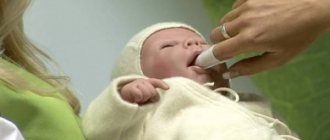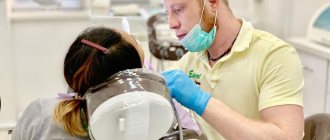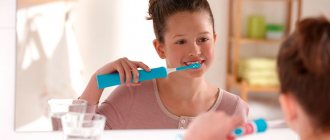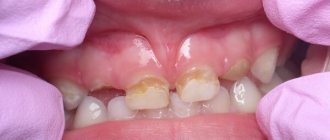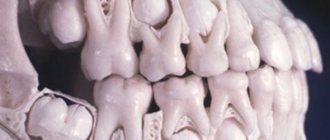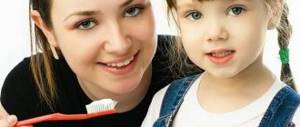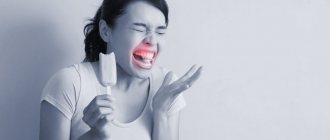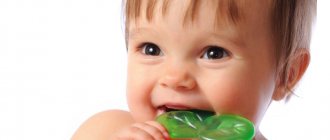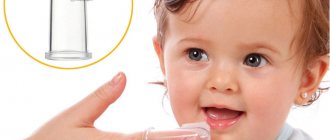Many parents believe that children need to start brushing their teeth only after complete teething. However, it is not. It is necessary to carry out hygienic treatment of the oral cavity from the moment when the first teeth begin to erupt. Plaque remains on the tongue and cheeks, which can serve as a good area for the spread of pathogenic microflora. To prevent this from happening, parents should clean it themselves. There are special toothbrushes for little ones for this purpose. Toothbrushes for children vary depending on age. Even an electric toothbrush may be suitable for older children.
A fingertip for cleaning gums and first teeth – a toddler’s first toothbrush
A child’s first toothbrush is usually a finger cap, which is a silicone “cap” with soft silicone bristles that is placed on the mother’s finger.
This brush will not scratch children’s delicate gums, improve blood circulation and provide a gentle massage of the gums.
There are no dangerous components in the fingertips, and caring for them is easy.
The recommended age for using finger pads is 4-10 months. But you shouldn’t get carried away with using this tool during teething.
What are dental wipes for?
Dental wipes are designed to remove food debris and microbial plaque from a baby's gums and are an alternative to a toothbrush for children under 5-8 months. Most wipes are approved for use from 4 months due to the content of sodium salts of benzoic acid. They are used in the food industry as a preservative and are officially considered a food additive.
Dental wipes Asepta baby
You can also find other components in the composition, the use of which is contraindicated before four months of age. These include:
- lemon acid;
- sodium citrate;
- xylitol (a type of sugar found in many grains, berries and fruits).
“Toothpicks” - napkins soaked in xylitol
Glycerin is used as a softening base, and the impregnation formula may contain plant extracts, for example, green tea, chamomile or calendula extract. This composition helps to provide comprehensive care for the child’s gums and prevent infectious and inflammatory processes.
Note! The most popular brand of dental wipes for infant gum care is Spiffies. One package contains 20 hermetically sealed fruit-scented wipes, suitable for daily use from four months of age. The only disadvantage of this product is the high cost (about 500 rubles per pack).
Spiffies dental wipes
What do you need to know?
- The brush wears out within 1-2 months due to active itching of the gums in children at this age.
- The brush should be changed according to the instructions. And not only for hygienic reasons, but also because of the risk of silicone pieces from the brush getting into the respiratory tract.
- At the slightest sign of damage to the integrity of the brush, it should be replaced with a new one.
- The duration of brushing with a finger is longer than that of standard teeth brushing: in general, the procedure takes about 4 minutes.
Features of care
It is important not only to choose the right brush, but also to know the features of caring for it. Following the recommendations of dentists will help extend the life of your teeth and improve the quality of hygiene procedures. After each use, the product must be washed with warm water and baby or antibacterial soap. You can also use natural laundry soap for this purpose, but after the procedure it must be rinsed thoroughly. If this is not done, a characteristic odor will remain on the product, and the child will refuse to brush his teeth.
It is best to store the brush in a special case, but you do not need to put it away immediately after use. After washing, it is better to put it in a clean towel or napkin and leave for 30–40 minutes. This is necessary for the product to dry completely. Regular drying with a towel is not enough for this, because moisture accumulates between the tubercles located on the surface of the brush, and it is quite difficult to dry these places.
So, the main selection criteria:
- High-quality plastic (request a certificate from the seller).
- Rigidity. For your first brush, choose the softest or ultra-soft bristles. Medium hard bristles will be needed from 3 years of age.
- Natural or synthetic? It is highly not recommended to choose a brush with natural bristles for a child - it is much inferior to the synthetic version in terms of wear resistance and the rate of growth of bacteria on the surface. Natural bristles allow bacteria to multiply very quickly, and regular sterilization quickly renders the brush unusable. Among the new products of recent years we can highlight bamboo bristles. Its service life is only 1 year, and without proper drying, fungus quickly forms on the brush. And another option is silicone bristles, but this option is only suitable for periods “to the teeth” and during teething (up to 1 year). Synthetic bristles remain the ideal option.
- Length of bristles. For babies over 1 year old, its length should be about 11 mm. However, you can also choose multi-level bristles with a V-shaped arrangement of synthetic bristles for ideal cleaning of rare teeth with serious gaps.
- Pen. It should have rubber anti-slip inserts and a flexible connection to the head. As for the length, the handle should not be too long, but should still remain optimal for a child’s fist. From 2-5 years, the length of the handle can reach 15 cm.
- Head size. For a one-year-old baby, the size of the brush head should not exceed 15 mm. And to get a more accurate orientation, look into the toddler’s mouth: the length of the brush head should be equal to the length of 2-3 of the baby’s teeth. From 2 years old you can look for a brush with a head of up to 20 mm. The shape of the brush head must be streamlined and smooth (so that there are no corners, burrs or scratches).
- The presence of a rubber brush for the baby's tongue on the back of the brush.
- As for the design , it all depends on the mother and the baby himself. Let him choose the design of the brush himself - then you won’t have to persuade your child to brush his teeth.
When should you start oral hygiene?
Preferably from birth, and not from the moment the first tooth erupts.
Before it appears, using special devices, you can prevent childhood candidiasis (thrush); growth and reproduction of infection that causes sinusitis, tonsillitis, sore throat, meningitis. To do this, purchase a fabric fingertip. When the first tooth has erupted and from the moment until the child is able to carry out the cleaning procedure on his own, it is recommended to use a silicone fingertip. Where can caries come from in young children? Many toddlers suffer from regurgitation syndrome.
The milk in the stomach and up the esophagus into the oral cavity is already mixed with hydrochloric acid, which is part of the gastric juice. That is, the milk automatically becomes sour. And such an environment is an excellent “soil” for the proliferation of bacteria. According to statistics, in 56% of children the cause of the development of chronic sinusitis is the lack of normal oral hygiene. As soon as the first tooth emerges, start using a silicone finger guard. Vegetables and fruits, when introduced into the diet, make the environment in the oral cavity acidic. If you do not cleanse, bacteria will mercilessly penetrate the porous enamel, causing the development of inflammation and caries.
Silicone and fabric baby finger pads from the following companies are popular: Canpol babies, Pigeon, Philips Avent, Tommee Tippee. Which one to choose is up to you. The only thing that can be noted is that don’t save money, try proven companies, for example, Canpol babies.
What to focus on?
- For children up to 3 years old. Pastes for this age should not contain fluoride at all.
- For kids 3-4 years old. The fluorine content in pastes should not exceed 200 ppm, and the abrasive content (approx. RDA) should not exceed 20 units. There must be an inscription about the safety of the paste when swallowed (as for any paste “from 0 to 4”).
- For children 4-8 years old. In these pastes, the abrasiveness can reach 50 units, and the fluoride content can reach 500 ppm (but no more!). The paste may have anti-inflammatory properties and contain appropriate herbal ingredients. From the age of 6, you can add dental floss to your toothbrush, which you also need to teach your child to use.
- For children 8-14 years old. These pastes can already contain up to 1400 ppm of fluorine, but no more than 50 ppm of abrasive.
- From the age of 14, children can already use traditional versions of adult toothpaste.
Is sterilization necessary?
Recently, devices for sterilizing children's toothbrushes have appeared on the market, which provide antibacterial treatment using steam.
Sterilizers can be used not only for children's brushes, but also for regular ones.
Experts consider the use of sterilizers inappropriate for several reasons:
- The service life of a children's toothbrush is about 2-3 months. After this, it must be replaced, since such a brush loses its hygienic and consumer properties.
- All modern products are made from synthetic materials in which the growth of pathogenic flora is practically impossible. To ensure hygienic treatment and remove bacteria from the surface of the product, it is enough to wash it with warm water and soap.
- Steam treatment can lead to deterioration of the silicone properties and faster deformation of the product.
Ingredients of children's toothpastes: what else do you need to know about children's toothpastes?
- Titanium dioxide or silicon dioxide can be used as abrasives, which are gentler on the enamel compared to calcium and sodium carbonate.
- Avoid baby toothpastes with antibacterial additives such as chlorhexidine, triclosan or metronidazole.
- As for the foaming component, it is better to choose a paste without it at all - SLS (sulfates) are harmful even to an adult body. Among the sulfate-free toothpastes, we can note the brands Weleda, Rox, Splat, Natura Siberica, etc.
- Only natural ingredients – pectins – should be used as thickeners.
Advantages
The product is soft, long, with a comfortable handle .
Note! Bristles of different lengths thoroughly destroy plaque without damaging the enamel and provide soft, delicate cleaning.
On the back of the product there is a grooved surface for cleaning the tongue.
Models are sold in which the head with bristles can be removed and replaced with another one sold as a set.
It is very practical and functional.
Systematic use of a silicone cleaning device helps prevent the development of the inflammatory process and reduces bleeding.
This tool will be very useful and effective if...
- The child has already reached 6 years of age.
- The child knows how to rinse his mouth and spit out the contents so as not to swallow any liquid accidentally found in the mouth.
- The rinse aid does not contain harmful components.
- The mouthwash is used for its intended purpose (for caries, for fresh breath, etc.).
- The procedure time does not exceed 30 seconds twice a day.
The site Colady.ru thanks you for your attention to the article! We will be very pleased if you share your feedback and tips in the comments below.
Indications for use
The model with silicone bristles is an excellent choice for those with increased tooth sensitivity and gum disease.
Keep in mind! The product is recommended for use when:
- gingivitis;
- periodontitis;
- periodontal disease;
In combination with a paste for sensitive teeth, doctors recommend using this device during restorative therapy after whitening .
Reviews
Below are some customer reviews. If you have something to say, leave your feedback in the comments below the article, it will be useful to our readers.
Anna Chizhova, Moscow.
I use a Jack N' Jill toothbrush to brush my child's teeth. Very pleased. The main thing is that the product is safe for the baby.
I periodically scald the product with boiling water to avoid unnecessary problems, although it is known that bacteria do not live in silicone.
The thing is very functional. I recommend it to all parents.
Maxim Volkov, Saratov.
I've never heard of silicone brushes before, I've always used regular ones.
For the sake of experiment, I decided to purchase this miracle remedy at the pharmacy. The device cleans in the same way as a regular one. I didn't notice any difference.
In addition, the model is quite expensive compared to its conventional counterpart. I advise you not to waste your money.
Valentina Seregina, Tver.
The silicone brush is a product that was developed exclusively for people with problem gums.
You need to carefully choose a model, pay attention to the quality of the bristles and their hardness.
Silicone devices clean the surface of teeth well, but may not be suitable due to their overly aggressive action.
Anna Popova, Barnaul.
Silicone brushes are certainly safer; bacteria do not accumulate on them. If a person does not have problems with teeth and gums, it is better to give preference to conventional models.
It is important to purchase a quality product, even taking into account its expensive cost. The products are very durable, do not deform, and heads can be changed.
The determining factor is the degree of softness of the bristles. If it is hard, you can cause even more harm to yourself.
